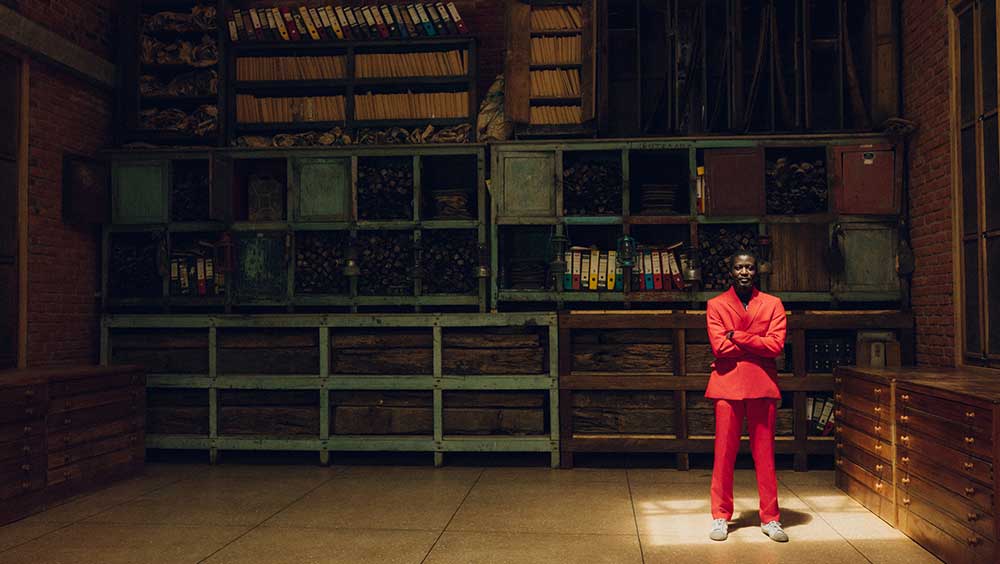
Ibrahim Mahama. Photo © Carlos Idun-Tawiah. Courtesy White Cube.
by VERONICA SIMPSON
Ibrahim Mahama (b1987, Ghana) is a genius at creative re-use, repurposing the furniture, fabric and infrastructure of failed colonial projects as viscerally affecting sculptures and installations. From jute sacks to old school desks, he deploys the rich patina of age and evident history - the legacies of 20th-century trade and industrialisation - to interrogate the failures of the past while offering forums for discussions around the future. Represented by White Cube, he has had solo shows all over the world and exhibits regularly at the Venice Biennale. Mahama has had an outstanding 2023, ending the year with his curatorial and artistic visions visible at the Venice Architecture Biennale, the Bienal de São Paulo, the 35th Ljubljana Biennale of Graphic Arts (as artistic director), and the Chicago Architecture Biennial.
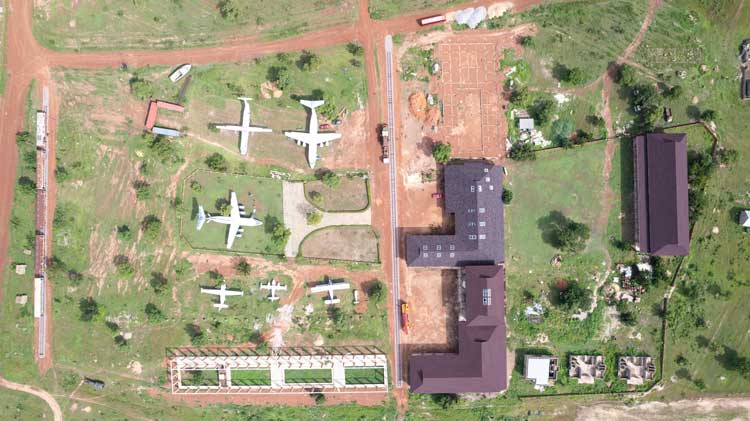
Aerial view of Red Clay Studio with decommissioned airplanes for classrooms. © Ibrahim Mahama. Photo courtesy of the SCCA and Red Clay, Tamale.
The works of which he is most proud, though, are the buildings his art earnings have enabled him to design and construct in Ghana, to educate and inspire local communities and build a legacy for future generations. Even here, the rusting relics of trade and empire have been redeployed: in 2021, he spent US$1m from the proceeds of sales of his works to buy six decommissioned planes for his Red Clay Studio campus in Tamale, which opened in 2020. These are being repurposed as classrooms and screening rooms, along with a motley selection of late-19th-century railway carriages that he rescued from dereliction in the sidings of South Ghana – the only part of the country that British colonial powers apparently felt worthy of such transport infrastructure. Now, the Red Clay education campus (which also features Mahama’s studio) welcomes 100,000 visitors a year to its programme of exhibitions and screenings. This includes 2,000 pupils a week during term time, who travel from rural schools on buses, which Mahama pays for, to enjoy a tour of the facility and lessons in physics, computer science, basic engineering and creative thinking.
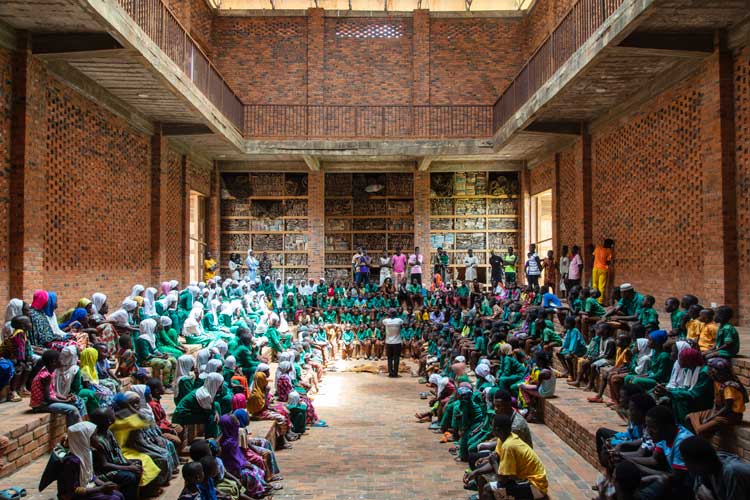
Red Clay Studio, Tamale. © Ibrahim Mahama. Photo courtesy of the SCCA and Red Clay, Tamale.
These projects have all arisen in response to perceived needs as well as opportunity. With the proceeds of his first sale – to Charles Saatchi, in 2014 – he decided to invest in a building on land his father had set aside for him in Tamale. He was originally planning a studio, but when he heard about the plight of leading 20th-century Ghanaian artists whose work was being lost due to lack of archives and resources, he turned it into the two-storey Savannah Centre for Contemporary Art, an archive, exhibition and research space that opened in 2019.
His buildings have also presented opportunities to deploy his sculptural skills at architectural scale, often using local clay bricks, baked in the sun. With his most recent acquisition, Nkrumah Volini – an abandoned grain silo from the time of Kwame Nkrumah, Ghana’s first president following the country’s independence in 1957 – he has paid close attention to its history and the local ecology so that it serves not just intrigued visitors but the bats who have made it their home.
As he says here: “For me this is not separate from my work, this is the core of my work. I invest everything that I make from my work into it. I am interested in building an institution that uplifts many generations.”
Studio International caught up with the artist on Zoom at his home in Ghana.
Veronica Simpson: From what I have read, you enjoyed your art education at Kwame Nkrumah University of Science and Technology. You said the professors tore up the rulebooks, bringing in philosophy, expanding your practice across all materials and not just restricting you to sculpture or painting.
Ibrahim Mahama: Yes, I went to the university in 2006 and between then and 2010 I studied painting and sculpture, but I majored in painting. The painting department professors, who had received a very traditional education, were interested in opening it up, encouraging artists to take inspiration from other departments – physics, mathematics or mechanical engineering, whatever – so we could expand our horizons.
When I did my masters, between 2011 and 2014, I became more interested in experimentation. My professors were very supportive. They were more interested in how art could be disseminated - particularly Professor Karî’kachä Seid’ou. He introduced the radical programme that changed the course of teaching there. He is my mentor, currently my PhD supervisor, but he was also my supervisor for my MFA. He is a Marxist and talked in class about the way art needed to go beyond the idea of the object, about needing to find ways in which we can disseminate art. It’s not so much about what you produce, but about the relationships that are created in the process when the object comes into being. That’s where my interest in building institutions and communities came from.
If you say you are an artist and you want to make or create something, does it have to be a commodity that someone has to buy, or can it be more like a community or an institution that can disseminate art a lot further?
VS: With the Savannah Centre for Contemporary Art (SCCA), Red Clay Studio and Nkrumah Volini, it sounds as if you have already created a very powerful set of spaces for disseminating and appreciating art and creativity. But can you tell me how you got started?
IM: With SCCA, I started in 2014. My first international show was at the Saatchi Gallery in London, when Charles Saatchi bought the work. I invested that money immediately into this building. I hadn’t even graduated from my MFA at the time, but I had spoken with my mentor about the possibility of building a studio in the north that could inspire future artists. My father is a civil engineer – he builds roads, bridges, houses – and he lives in the north and was excited about me coming to the north to settle, to build a studio on a piece of land he had bought for me many years ago. He offered to build it for me once I could provide the money for the materials and labour. We started building in 2014 and it took until 2019 before I could complete it.
.jpg)
Savannah Centre for Contemporary Art, Tamale.
Photo © Savannah Centre for Contemporary Art,Tamale.
Everything I do comes from the sale of installations or works I have produced. And it takes a long time to sell a work. Over that period, a couple of colleagues were researching older artists whose works were becoming extinct because of the lack of cultural institutions in this country – all those artists you never see, their families keep the work, but it ends up being thrown out or ruined because there isn’t the right space to store them in. One of those colleagues was doing a thesis on the Ghanaian modernist Kofi Dawson (1940-2021). I became interested in Dawson and started visiting his studio, and talked to one of my colleagues in Ghana about curating older artists’ work in my studio. At that point, I thought why not change it from a studio into an institution that can be dedicated to retrospectives. That’s how SCCA was born, because there was a gap in the system that needed to be filled. There were no institutions for the younger generation of Ghanaians to connect to the work of older generations, including engineering, architecture and textiles. We started off by doing retrospectives and then international shows.
VS: Designing this building must have been a fantastic opportunity to work at an architectural scale. What were the important elements for you?
IM: In all the buildings I’ve worked on, light is very important. I learned quite a lot from the old railway buildings in Ghana, built by the British in the early 20th century, especially the depots meant for repair, for railway infrastructure. There would be huge cranes suspended on the beams, cutting across the space and skylights in the building, so even when you go into a building and there’s no electricity, you can still see. Ghana has an energy problem and there’s barely any electricity running. All the time I’m thinking: “How can we have natural light in this space, so the building is sustainable not just in terms of environment but also economically?”
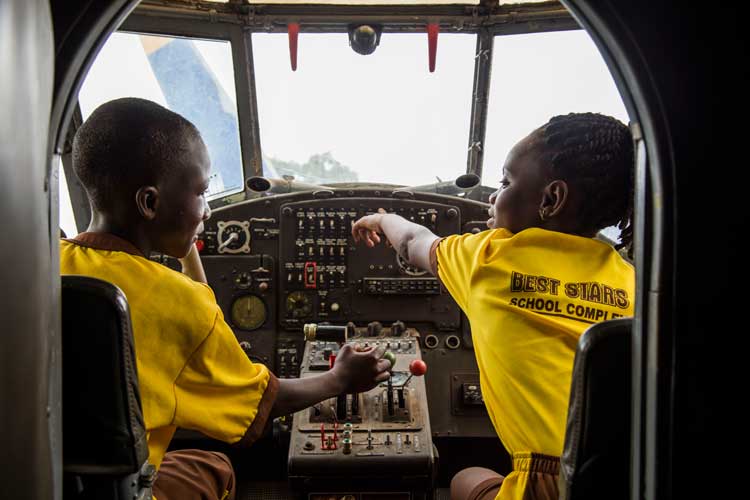
School children enjoying a lesson in the Red Clay Studio's airplane classroom. Photo © Savannah Centre for Contemporary Art
With the SCCA, Nkrumah Volini and Red Clay Studio, when we put all the institutions together, the energy we use is not more than the equivalent of €200 (£175) a month – in a single family’s home, they spend more than that. We have 7,000 sq metres (75,350 sq ft) of space, but we don’t spend much on electricity because of the way I designed it. There are no cooling systems and no fans: ventilation goes through the building by itself, the building cools itself. Also, we don’t spend money on repairs. The buildings are made out of baked clay, so you don’t need to paint them. There is a lot of dust in the north, and most of these buildings are close to major roads, so when trucks travel on the roads and dust goes into the air, it settles on the buildings. If people paint them, they are always having to repaint them. Traditionally, people built with clay and cow dung and straw. Because this is an institution that is meant to be permanent and perform different functions, we had to use baked bricks. The colour, aesthetics and the nature of the clay allows the building thermally to be a lot cooler than using concrete.
Some have skylights so the light comes from above. Some have jalousie windows that allow light and air to come through. Some will have glass windows and the light hits the ground and bounces off into the space. We barely need electricity except for some of the permanent video works. We have electricity generators for backup.
With western institutions you don’t have this problem, so the museum director doesn’t have to think about these things when they are designing. Here, you do have to think about them. Art doesn’t have to pretend we have all these amenities when we don’t. The artist has to think about his work in relation to the conditions that exist within the society, so both of those things can go hand in hand. The quality isn’t any lower, but the work has to be sensitive to the local conditions. If the work needs to go to a village somewhere for kids to be able to see it, you know these conditions are inherently part of the design of your work.
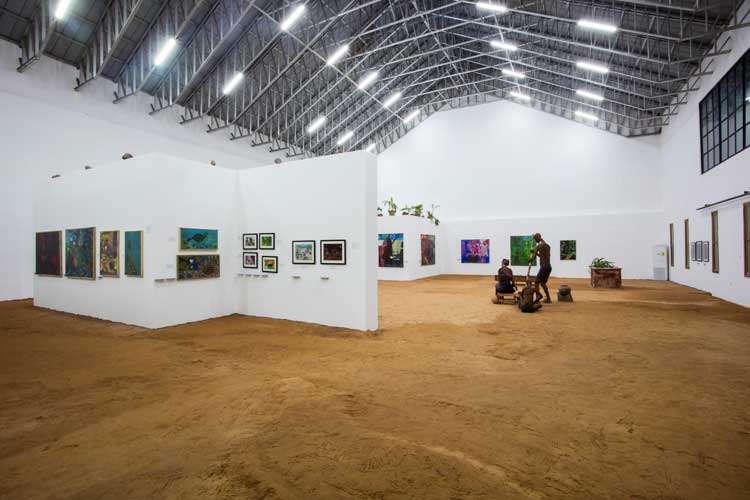
Akutia: Blindfolding the Sun and the Poetics of Peace, SCCA, Tamale, Ghana, 4 Sep 2020 - 7 Mar 2021. © Ibrahim Mahama. Photo courtesy of the SCCA and Red Clay, Tamale.
VS: It seems you were ahead of the curve in 2014 thinking about this, when in western Europe the idea of energy-neutral buildings is still a novelty.
IM: They are very simple things. In the north, we have too much sunlight, you can’t avoid it. I’ve been working on the idea of solar for a long time. I’ve also been trying to get access to drinking water through the ground, through boreholes, but the water in the ground is too salty.
In most of the villages where the Red Clay Studio was built, there was no electricity. I had to pay for the wires and everything. There was no drinking water. The people in the community were drinking the same water as their cattle. I had to pay the water company to connect the pipes to bring the water there. Even then, for three years we have not had a drop of water flowing in our pipes. We have to buy tanks of water to bring in for cleaning the institution, flushing toilets and so on. There are all these things inherent in the way you design. I am borrowing ideas that have been in existence in our history, in different communities, across the country and bringing it into a cultural institution.
VS: It’s interesting that you are not daunted in the face of all these challenges. In fact, you have opened two more buildings since the SCCA.
IM: I didn’t buy the land for SCCA. It belonged to my father. He bought it when he was a young man, and he gave it to me. When he bought the land 35 years ago, no one was living in that area. Now, it’s a full-grown community. Then my older sister, who had been living in Canada, came back with her husband to set up a school. She saw that there was a piece of leftover land nearby that nobody wanted to buy and asked if I would be interested in buying it, saying that I might want to build a house one day. I was reluctant, but I bought it. As I kept travelling, over time, I realised there was a lot of potential to expand this space. It is on a large parcel of land and I had neighbours who had bought land next to it, but nobody was building on it, so I thought maybe I could negotiate with them and buy their land and expand this space from a house into a bigger studio that could become an institution. Then I went to Manchester, to the Whitworth, to do Parliament of Ghosts. And I thought: “Why not build a parliament as a permanent architectural form?”
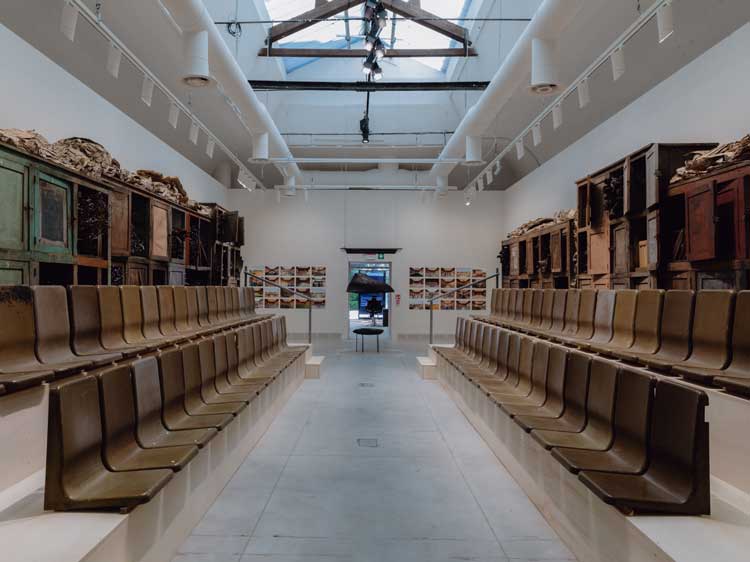
Ibrahim Mahama. Parliament of Ghosts, 18th International Architecture Exhibition of La Biennale di Venezia curated by Lesley Lokko
20 May – 26 November 2023. © the artist. Photo © MDM: Matteo de Mayda. Courtesy La Biennale di Venezia.
In 2019, just before Covid, I was interested in the (aformentioned decommissioned) planes, and the trains for which I was already negotiating, and thinking about how they could be placed in pedagogical forms and used as classrooms. Together with the greenhouse, which is just now being built, I want to think about ways in which they can expand a relationship between ecology, the built environment, the residency and archaeology.
With SCCA, I made it into a public institution. Red Clay Studio is still my studio, with a private space, but I’m interested in how it becomes a larger institution and more public. Almost 100,000 people visit every year just to see contemporary art - exhibitions, films and festivals. I started thinking about what those possibilities could be and what it means to our generation to produce art. Is a studio a place where the artist goes to be in isolation to contemplate, or is it a place where people come to discuss ideas, where the premises of failures are discussed? It’s almost like a parliamentary floor, a place of debate, to try things or assemble things that reflect historical failures, but to open up new possibilities to another generation.
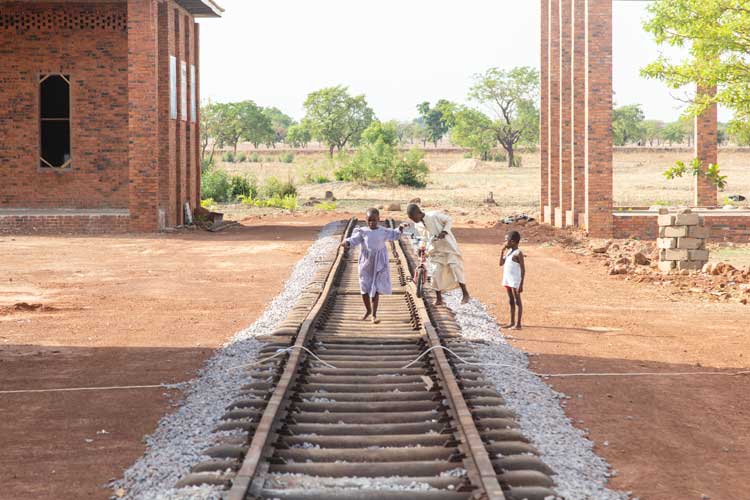
Red Clay Studio. © Ibrahim Mahama. Photo courtesy of the SCCA and Red Clay, Tamale.
That’s why we celebrate trains, because the trains never came to the north. When the British built the Ghana railway in the late 1800s, they took labour from the north of Ghana to build a railway in the south, post-slavery, but there was never a train track that came all the way to the north. People in more than half of Ghana, those who had never gone to the south, had never seen trains before. And they had started removing the lines for scrap. I thought: “Why not take this historical form and take it to a new geographical location and insert it there?” It might be a space where children might be inspired by new ideas. Imagine a child sitting in a train that was used to extract gold, and now it is a classroom, which somehow sits on a train track in a landscape for which it was never intended. It’s an impossible idea.
We are interested in miracles, but also in possibilities, and how the crisis of history comes back in a way to create new possibilities. Red Clay was born out of that.
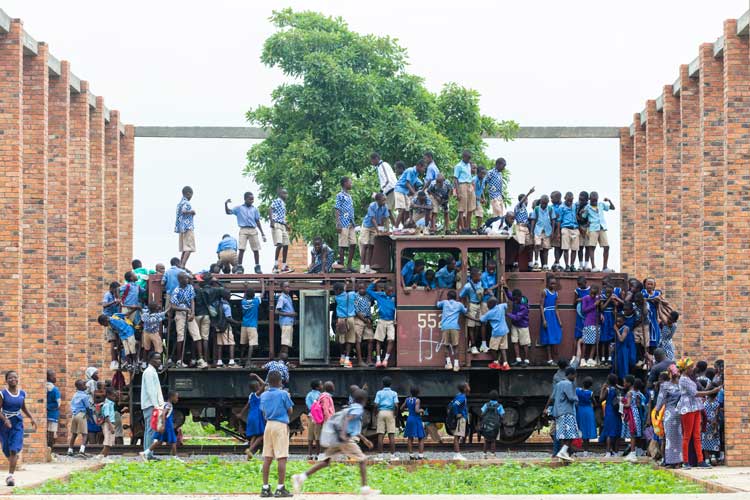
Visitors exploring the transported trains at Red Clay Studio, Tamale. © Ibrahim Mahama. Photo courtesy of the SCCA and Red Clay, Tamale.
VS: What impact has bringing the trains to the north had?
IM: It was a lot of work and very expensive. But between when the trains arrived in January (2023) and now, the kind of discussions and conversations that have happened around them are completely transformed.
There is a sense of possibility, of decay - because, in Ghana, we’ve been dealing with this sense of decay for a long time. When Ghana gained independence, President Nkrumah made a statement: he wanted to show that the black man was capable of managing his own affairs, creating spaces that work for us. And that got lost because of bureaucracy and corruption, and scarcity of resources so that, over the years, the public institutions have not functioned as they should.
Nkrumah Volini is the last space – though now there is a Russian cemetery I’m acquiring, an ocean pool I’m bringing in to the institution and a forest area where, several centuries ago, we used to bury some of our ancestors, which I’ve acquired from the villages so we can turn them into sculpture spaces or public spaces where people can go to recreate historical forms.
Nkrumah Volini was built by the Russians between the late 1950s and 1966 when Nkrumah was overthrown. These buildings were built to store food so that Ghana didn’t have to export all the raw materials to Europe … These buildings were abandoned, some of them were privatised, some demolished. My idea was: why can’t we use the capital of art? By making art, by making drawings of these spaces or other works, we can use the money from the art world to buy back these buildings and convert them into public spaces.
The building was strange; some said it was a prison. They called it Nkrumah’s dungeon, Nkrumah’s prison. I wanted to keep the name so that the history of the building could follow the narrative and could also open up new trajectories, new meanings. We extracted the soil that had been dumped in it and realised there was an entire ecosystem in the building - there were bats living in there. Local people extracted the water for their farming, and to cook with. The building had so much life in it even though it had been abandoned for so long. But we refaced the building so that we could have exhibitions in it, so people can connect with it in a different way. We breathed new life into it.
VS: And the bats are still there?
IM: Yes, the building is designed so that the bats can fly out in the night and feed and then fly back in.
VS: Given all these additional things going on, how do you find time for your own art practice?
IM: I have a couple of assistants with whom I work. And my work also involves empowering local economies. I might employ a dozen people to produce a work so that the capital is redistributed across these people, so it involves a lot of hands. They are big and monumental, but I involve the people I need to do the work.
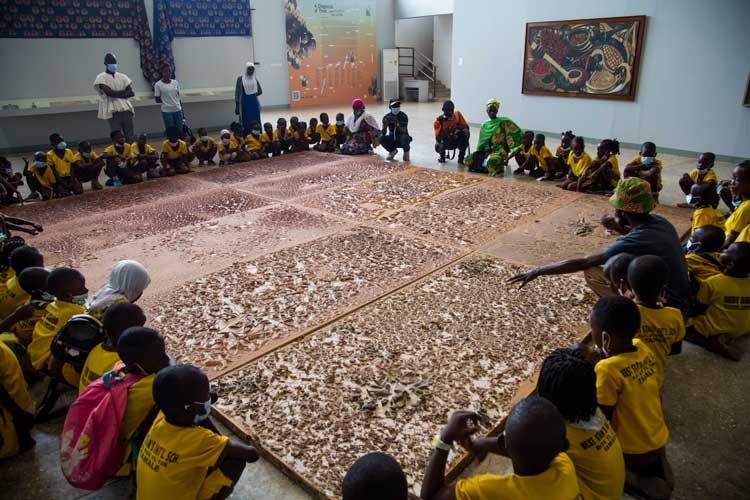
The artistic director of SCCA Tamale Selom Kudjie guiding school children through one of the exhibitions at Red Clay Studio. © Ibrahim Mahama. Photo courtesy of the SCCA and Red Clay, Tamale.
VS: It sounds as if everything you are doing on the ground in Ghana is way more exciting than anything that could be going on in a gallery in Manchester or Venice.
IM: Yes, exactly. These are my most significant artworks, but also, interestingly, I don’t get to spend too much time at home, I am always travelling, teaching, doing exhibitions around the world. At the end of the day, I make sure that whatever residues come out of it in terms of capital, everything comes back to Ghana to support the ecosystem I am building.
But for me this is not separate from my work, this is the core of my work. I invest everything that I make from my work into it. I am interested in building an institution that uplifts many generations. For me, it’s important that you don’t separate making an object from building this institution, ecology, building a greenhouse, making workshops, making an exhibition, paying for buses to go to villages to bring schoolkids and their mothers to see contemporary art. All these things are cultivations that require time, and it requires a certain kind of mindset.
There is a real sense of debt, not just economically but ideologically in our population – not just the older generation but also the younger. How do we break that? Through culture, strengthening culture, building cultural institutions across different spaces.
VS: What impacts have you seen from these initiatives so far?
IM: Well, it’s quite interesting. A lot of parents these days come on their own. Not just Ghanaian people, international people, too, a lot of expats. All the embassies from Accra come for our programmes; they even come and do workshops. Normally, everything is done in Accra, or sometimes in Kumasi, because of the art school and the university there. The kids bring their fellow kids and give them tours. We have to create an environment and a system that creates equal opportunity.
Word has spread: a professor from Stanford wants to come with their students to do research into solar panels. It’s something that is unfolding. We are still living in that crisis and in debt. This institution is trying to clear a path for things to happen.
VS: What do you feel this education in creative culture brings to a community?
IM: It opens up the possibilities that the world has to offer. I never think about it economically or financially, I think about it in terms of life itself. For me, the entire purpose of existence is that we should be able to relate to one another, to the world that we’re in, to relate to the ecosystems that exist. Art is supposed to create a moment in time that allows us to be able to reflect. But most of the time it’s not able to do that because of the markets and how things operate within the art world. I think it’s important that we’re able to invest back into the curriculum of art, open up different possibilities, explore different examples, that can allow for new ideological premises, beyond the very stiff capitalist system that we inherited, that doesn’t allow for many possibilities.
For me, art is only about potentials and possibilities. In areas where traditional science and engineering cannot create because the rules and regulations are there, art breaks all those boundaries and allows for us to gather new forms of courage, new forms of imagination, to push the world forward in a much more sustainable way.
• Ibrahim Mahama’s work can be seen at the Bienal de São Paulo, Brazil, until 10 December 2023, at the Chicago Architecture Biennial, until 11 February 2024, and at Fruitmarket, Edinburgh, 22 June to 6 October 2024. He is artistic director at the 35th Ljubljana Biennale of Graphic Arts, Slovenia, which runs until 14 January 2024.